Evaluating the effectiveness of nighttime natural virtual scene on relaxation and sleepiness
IF 4.9
2区 医学
Q1 ENGINEERING, BIOMEDICAL
引用次数: 0
Abstract
The natural environment significantly affects the release of human stress and sleep quality. Variations in lighting and color brought about by the sun play a crucial role in the regulation of our physiological functions and circadian rhythm. This study aims to examine the effects of virtual beach environments at different times of the day (including day and nighttime) on relaxation and the promotion of sleepiness, compared to a control group using self-relaxation methods. The research variables included self-relaxation, daytime, and nighttime scenarios, with the nighttime scene featuring a starry sky and a campfire. We analyze participants’ physiological and psychological responses to uncover the impact of virtual scenes and self-regulation on transitioning from stress to relaxation. Psychological questionnaires gauged the levels of relaxation, calmness, and sleepiness. Physiologically, brain waves, heart rate variability, and heartbeat changes were evaluated. The results of our study indicate that all three groups could relax from stress, with participants immersed in the starry sky scene exhibiting the most significant reduction in heart rate and an increased sense of sleepiness. The self-relaxation group showed higher theta waves than other relaxation groups, possibly tied to deep contemplation. Through this study, we gained a better understanding of the effects of natural virtual reality environments on stress relief and the promotion of drowsiness. We plan to use the starry sky with a campfire virtual scene in experiments involving individuals who struggle with sleep difficulties in the future.

求助全文
约1分钟内获得全文
求助全文
来源期刊

Biomedical Signal Processing and Control
工程技术-工程:生物医学
CiteScore
9.80
自引率
13.70%
发文量
822
审稿时长
4 months
期刊介绍:
Biomedical Signal Processing and Control aims to provide a cross-disciplinary international forum for the interchange of information on research in the measurement and analysis of signals and images in clinical medicine and the biological sciences. Emphasis is placed on contributions dealing with the practical, applications-led research on the use of methods and devices in clinical diagnosis, patient monitoring and management.
Biomedical Signal Processing and Control reflects the main areas in which these methods are being used and developed at the interface of both engineering and clinical science. The scope of the journal is defined to include relevant review papers, technical notes, short communications and letters. Tutorial papers and special issues will also be published.
 求助内容:
求助内容: 应助结果提醒方式:
应助结果提醒方式:


